The Importance of Professional Communication for Nurses in Healthcare
VerifiedAdded on 2022/08/23
|10
|2366
|19
Essay
AI Summary
This essay delves into the critical importance of professional communication within healthcare settings, specifically focusing on the nursing profession. It emphasizes the necessity of clear, informative, and tactful communication among nurses, physicians, and patients and their families. The essay explores the significance of effective communication for ensuring patient safety and the delivery of optimal healthcare. It examines nurse-to-nurse communication, highlighting the reliability of bedside communication while also acknowledging potential challenges during patient transfers. Furthermore, it investigates nurse-physician communication, addressing communication gaps and emphasizing the need for collaborative teamwork. The essay synthesizes findings from various studies to illustrate the impact of communication training, the role of professionalism, and the importance of considering diverse perspectives in healthcare interactions. The conclusion reinforces the essentiality of professional communication for achieving positive patient outcomes and suggests the need for ongoing evaluation and training to enhance communication skills within the healthcare environment.
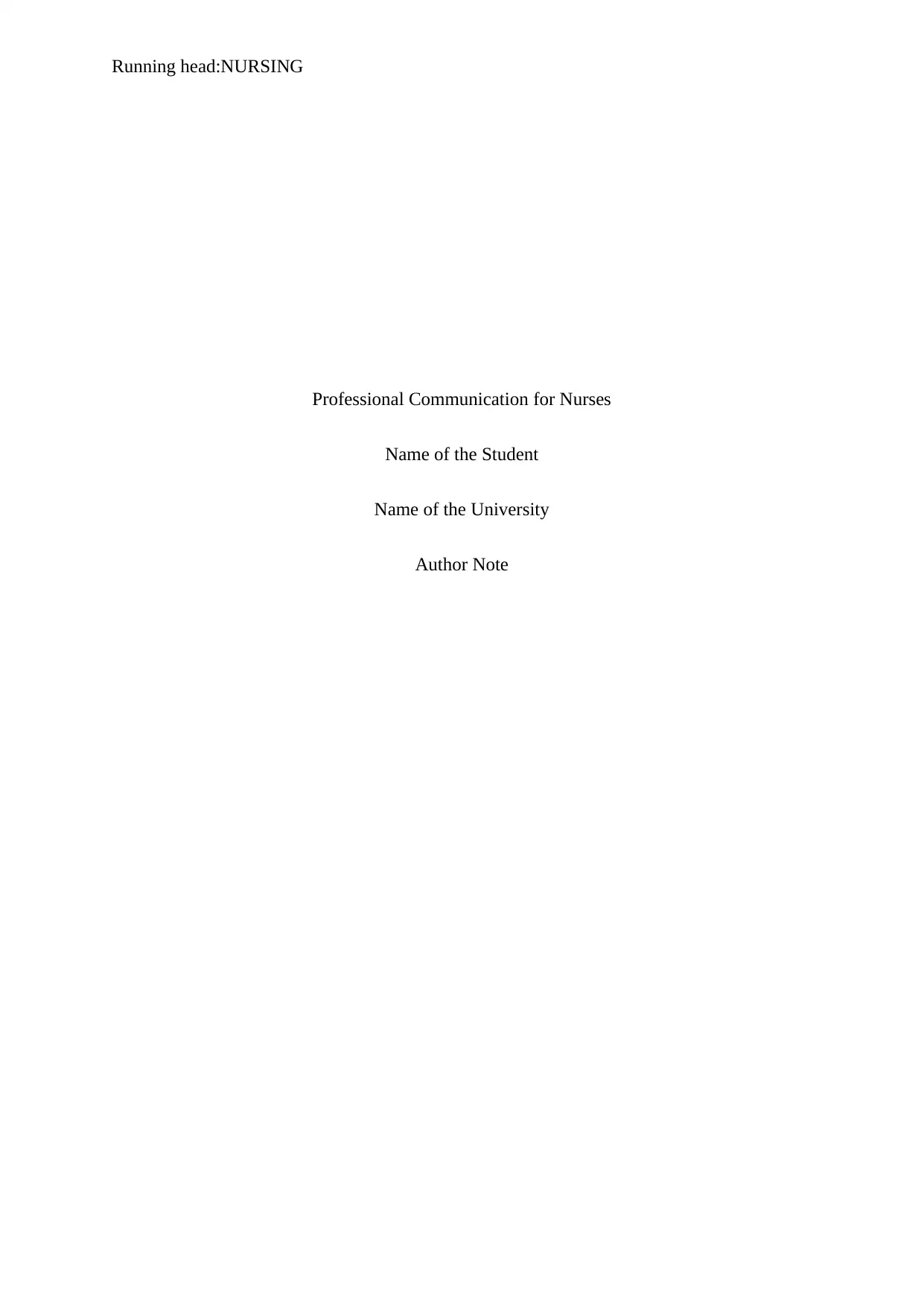
Running head:NURSING
Professional Communication for Nurses
Name of the Student
Name of the University
Author Note
Professional Communication for Nurses
Name of the Student
Name of the University
Author Note
Paraphrase This Document
Need a fresh take? Get an instant paraphrase of this document with our AI Paraphraser
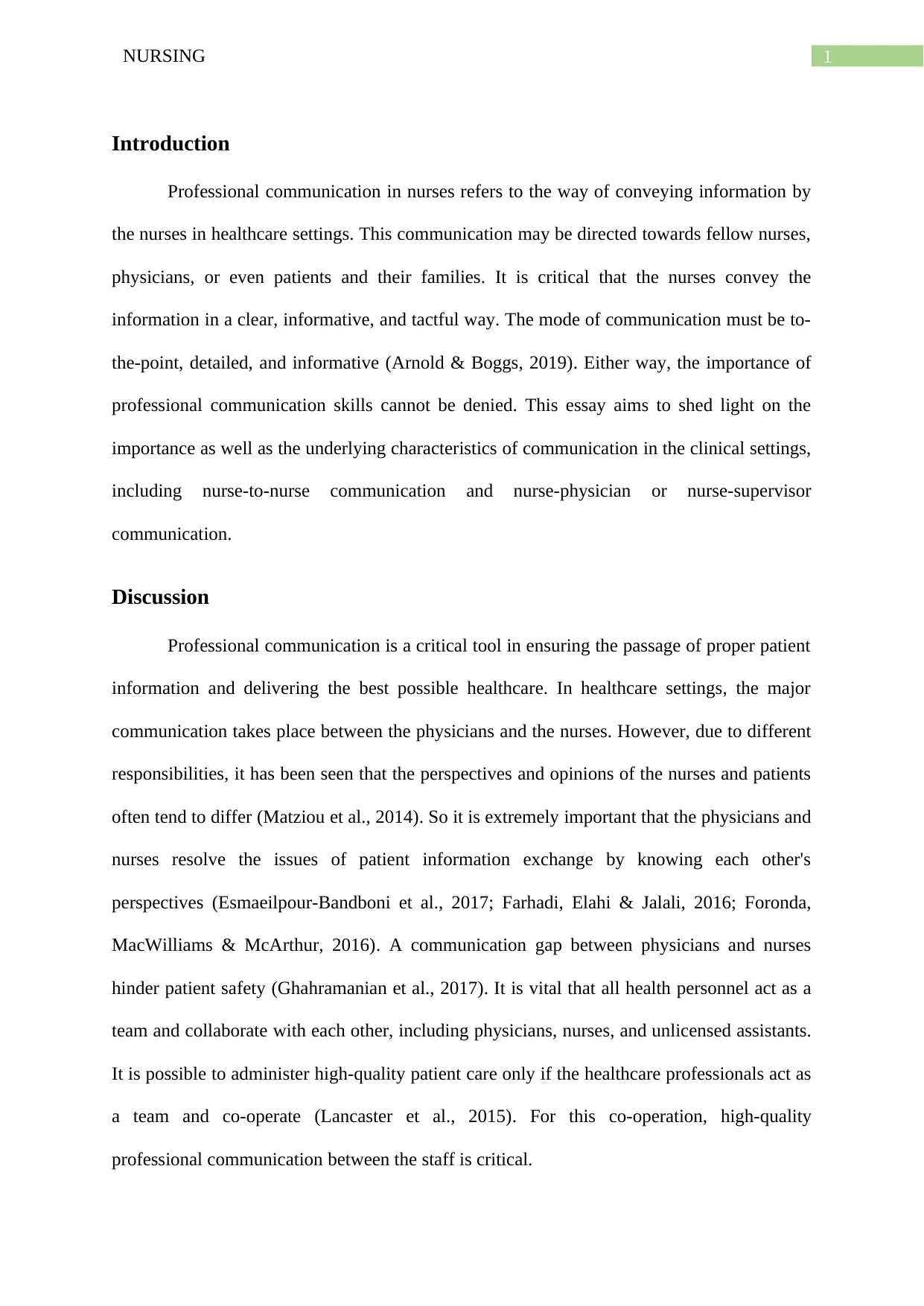
1NURSING
Introduction
Professional communication in nurses refers to the way of conveying information by
the nurses in healthcare settings. This communication may be directed towards fellow nurses,
physicians, or even patients and their families. It is critical that the nurses convey the
information in a clear, informative, and tactful way. The mode of communication must be to-
the-point, detailed, and informative (Arnold & Boggs, 2019). Either way, the importance of
professional communication skills cannot be denied. This essay aims to shed light on the
importance as well as the underlying characteristics of communication in the clinical settings,
including nurse-to-nurse communication and nurse-physician or nurse-supervisor
communication.
Discussion
Professional communication is a critical tool in ensuring the passage of proper patient
information and delivering the best possible healthcare. In healthcare settings, the major
communication takes place between the physicians and the nurses. However, due to different
responsibilities, it has been seen that the perspectives and opinions of the nurses and patients
often tend to differ (Matziou et al., 2014). So it is extremely important that the physicians and
nurses resolve the issues of patient information exchange by knowing each other's
perspectives (Esmaeilpour-Bandboni et al., 2017; Farhadi, Elahi & Jalali, 2016; Foronda,
MacWilliams & McArthur, 2016). A communication gap between physicians and nurses
hinder patient safety (Ghahramanian et al., 2017). It is vital that all health personnel act as a
team and collaborate with each other, including physicians, nurses, and unlicensed assistants.
It is possible to administer high-quality patient care only if the healthcare professionals act as
a team and co-operate (Lancaster et al., 2015). For this co-operation, high-quality
professional communication between the staff is critical.
Introduction
Professional communication in nurses refers to the way of conveying information by
the nurses in healthcare settings. This communication may be directed towards fellow nurses,
physicians, or even patients and their families. It is critical that the nurses convey the
information in a clear, informative, and tactful way. The mode of communication must be to-
the-point, detailed, and informative (Arnold & Boggs, 2019). Either way, the importance of
professional communication skills cannot be denied. This essay aims to shed light on the
importance as well as the underlying characteristics of communication in the clinical settings,
including nurse-to-nurse communication and nurse-physician or nurse-supervisor
communication.
Discussion
Professional communication is a critical tool in ensuring the passage of proper patient
information and delivering the best possible healthcare. In healthcare settings, the major
communication takes place between the physicians and the nurses. However, due to different
responsibilities, it has been seen that the perspectives and opinions of the nurses and patients
often tend to differ (Matziou et al., 2014). So it is extremely important that the physicians and
nurses resolve the issues of patient information exchange by knowing each other's
perspectives (Esmaeilpour-Bandboni et al., 2017; Farhadi, Elahi & Jalali, 2016; Foronda,
MacWilliams & McArthur, 2016). A communication gap between physicians and nurses
hinder patient safety (Ghahramanian et al., 2017). It is vital that all health personnel act as a
team and collaborate with each other, including physicians, nurses, and unlicensed assistants.
It is possible to administer high-quality patient care only if the healthcare professionals act as
a team and co-operate (Lancaster et al., 2015). For this co-operation, high-quality
professional communication between the staff is critical.
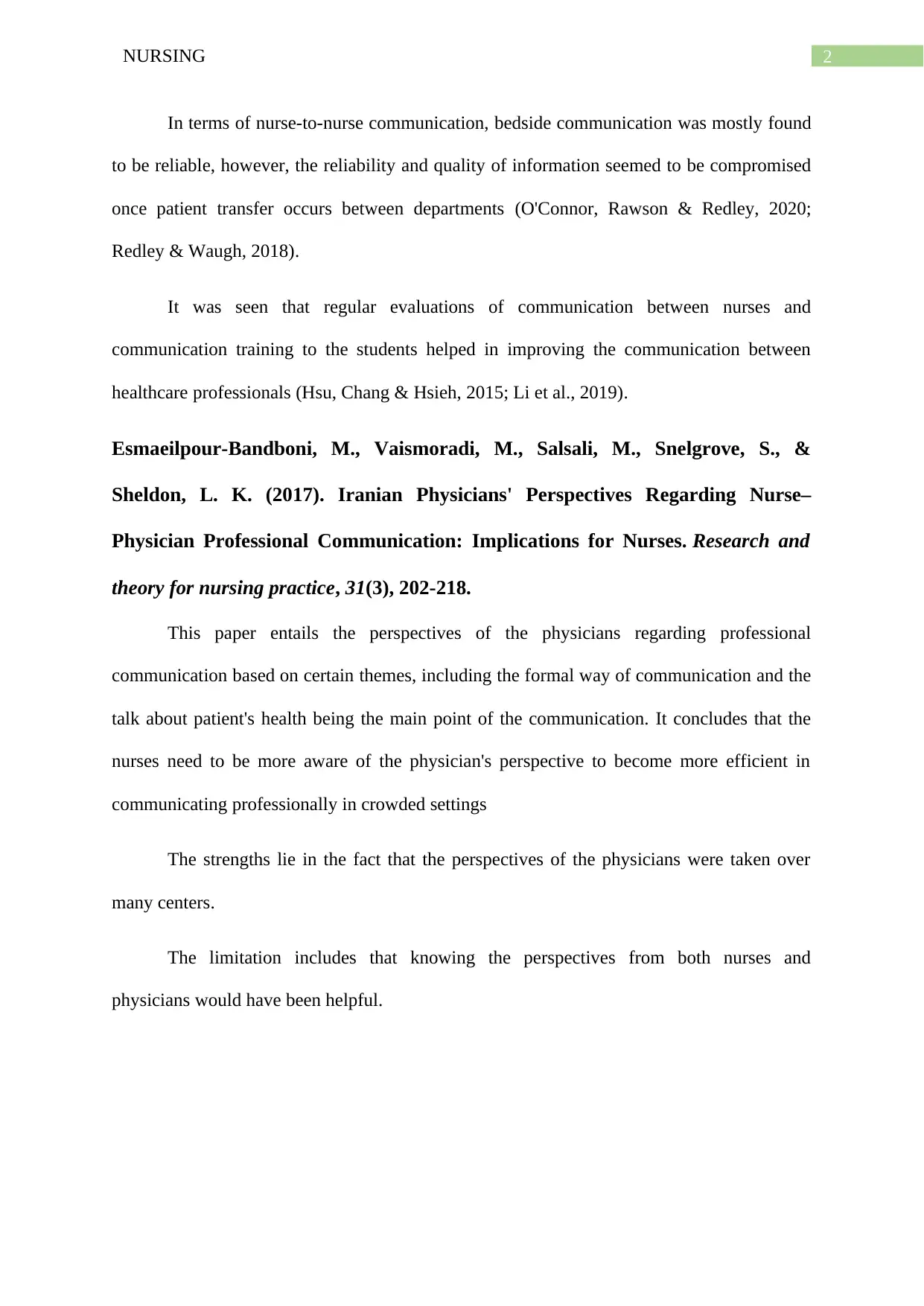
2NURSING
In terms of nurse-to-nurse communication, bedside communication was mostly found
to be reliable, however, the reliability and quality of information seemed to be compromised
once patient transfer occurs between departments (O'Connor, Rawson & Redley, 2020;
Redley & Waugh, 2018).
It was seen that regular evaluations of communication between nurses and
communication training to the students helped in improving the communication between
healthcare professionals (Hsu, Chang & Hsieh, 2015; Li et al., 2019).
Esmaeilpour-Bandboni, M., Vaismoradi, M., Salsali, M., Snelgrove, S., &
Sheldon, L. K. (2017). Iranian Physicians' Perspectives Regarding Nurse–
Physician Professional Communication: Implications for Nurses. Research and
theory for nursing practice, 31(3), 202-218.
This paper entails the perspectives of the physicians regarding professional
communication based on certain themes, including the formal way of communication and the
talk about patient's health being the main point of the communication. It concludes that the
nurses need to be more aware of the physician's perspective to become more efficient in
communicating professionally in crowded settings
The strengths lie in the fact that the perspectives of the physicians were taken over
many centers.
The limitation includes that knowing the perspectives from both nurses and
physicians would have been helpful.
In terms of nurse-to-nurse communication, bedside communication was mostly found
to be reliable, however, the reliability and quality of information seemed to be compromised
once patient transfer occurs between departments (O'Connor, Rawson & Redley, 2020;
Redley & Waugh, 2018).
It was seen that regular evaluations of communication between nurses and
communication training to the students helped in improving the communication between
healthcare professionals (Hsu, Chang & Hsieh, 2015; Li et al., 2019).
Esmaeilpour-Bandboni, M., Vaismoradi, M., Salsali, M., Snelgrove, S., &
Sheldon, L. K. (2017). Iranian Physicians' Perspectives Regarding Nurse–
Physician Professional Communication: Implications for Nurses. Research and
theory for nursing practice, 31(3), 202-218.
This paper entails the perspectives of the physicians regarding professional
communication based on certain themes, including the formal way of communication and the
talk about patient's health being the main point of the communication. It concludes that the
nurses need to be more aware of the physician's perspective to become more efficient in
communicating professionally in crowded settings
The strengths lie in the fact that the perspectives of the physicians were taken over
many centers.
The limitation includes that knowing the perspectives from both nurses and
physicians would have been helpful.
⊘ This is a preview!⊘
Do you want full access?
Subscribe today to unlock all pages.

Trusted by 1+ million students worldwide
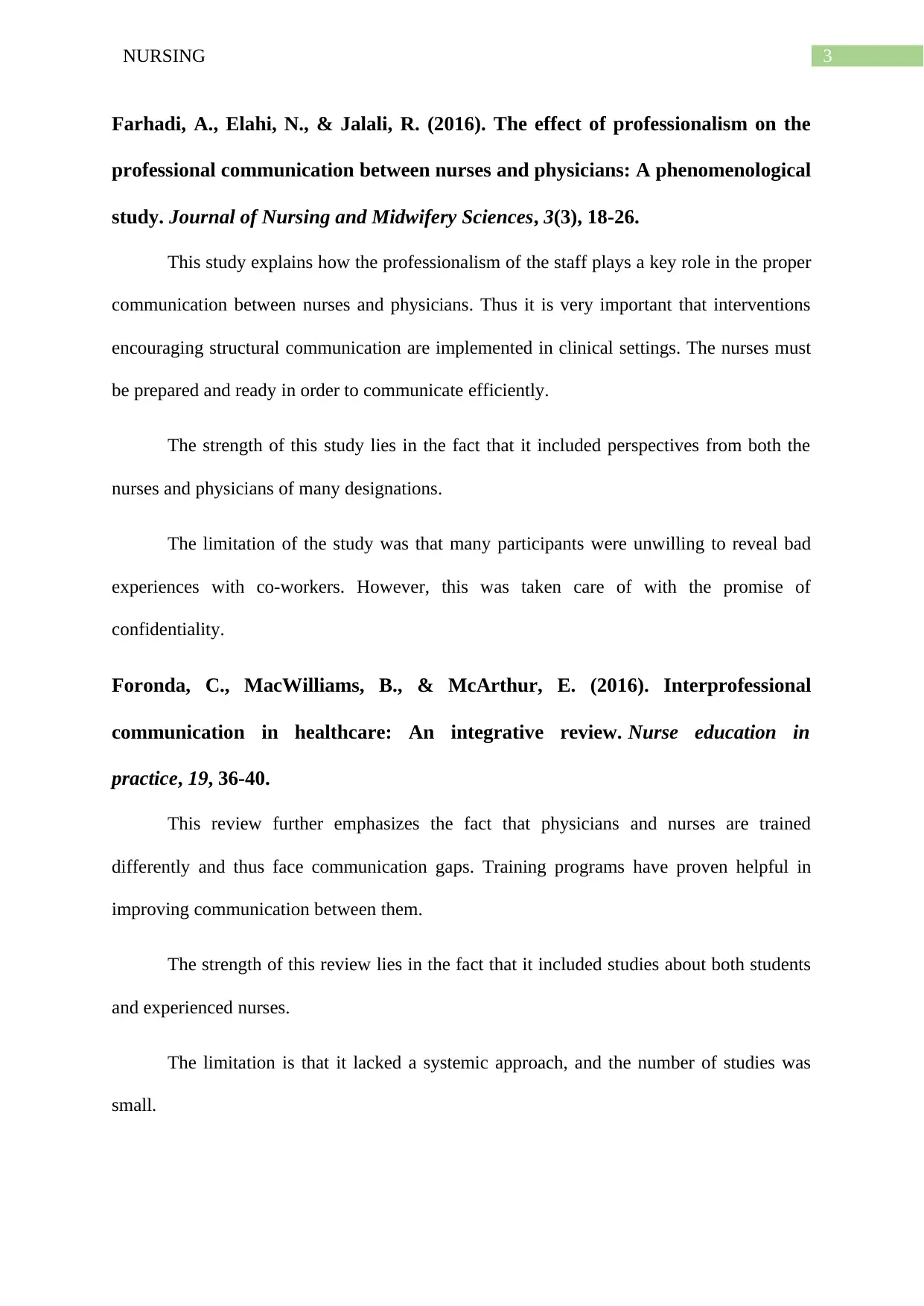
3NURSING
Farhadi, A., Elahi, N., & Jalali, R. (2016). The effect of professionalism on the
professional communication between nurses and physicians: A phenomenological
study. Journal of Nursing and Midwifery Sciences, 3(3), 18-26.
This study explains how the professionalism of the staff plays a key role in the proper
communication between nurses and physicians. Thus it is very important that interventions
encouraging structural communication are implemented in clinical settings. The nurses must
be prepared and ready in order to communicate efficiently.
The strength of this study lies in the fact that it included perspectives from both the
nurses and physicians of many designations.
The limitation of the study was that many participants were unwilling to reveal bad
experiences with co-workers. However, this was taken care of with the promise of
confidentiality.
Foronda, C., MacWilliams, B., & McArthur, E. (2016). Interprofessional
communication in healthcare: An integrative review. Nurse education in
practice, 19, 36-40.
This review further emphasizes the fact that physicians and nurses are trained
differently and thus face communication gaps. Training programs have proven helpful in
improving communication between them.
The strength of this review lies in the fact that it included studies about both students
and experienced nurses.
The limitation is that it lacked a systemic approach, and the number of studies was
small.
Farhadi, A., Elahi, N., & Jalali, R. (2016). The effect of professionalism on the
professional communication between nurses and physicians: A phenomenological
study. Journal of Nursing and Midwifery Sciences, 3(3), 18-26.
This study explains how the professionalism of the staff plays a key role in the proper
communication between nurses and physicians. Thus it is very important that interventions
encouraging structural communication are implemented in clinical settings. The nurses must
be prepared and ready in order to communicate efficiently.
The strength of this study lies in the fact that it included perspectives from both the
nurses and physicians of many designations.
The limitation of the study was that many participants were unwilling to reveal bad
experiences with co-workers. However, this was taken care of with the promise of
confidentiality.
Foronda, C., MacWilliams, B., & McArthur, E. (2016). Interprofessional
communication in healthcare: An integrative review. Nurse education in
practice, 19, 36-40.
This review further emphasizes the fact that physicians and nurses are trained
differently and thus face communication gaps. Training programs have proven helpful in
improving communication between them.
The strength of this review lies in the fact that it included studies about both students
and experienced nurses.
The limitation is that it lacked a systemic approach, and the number of studies was
small.
Paraphrase This Document
Need a fresh take? Get an instant paraphrase of this document with our AI Paraphraser
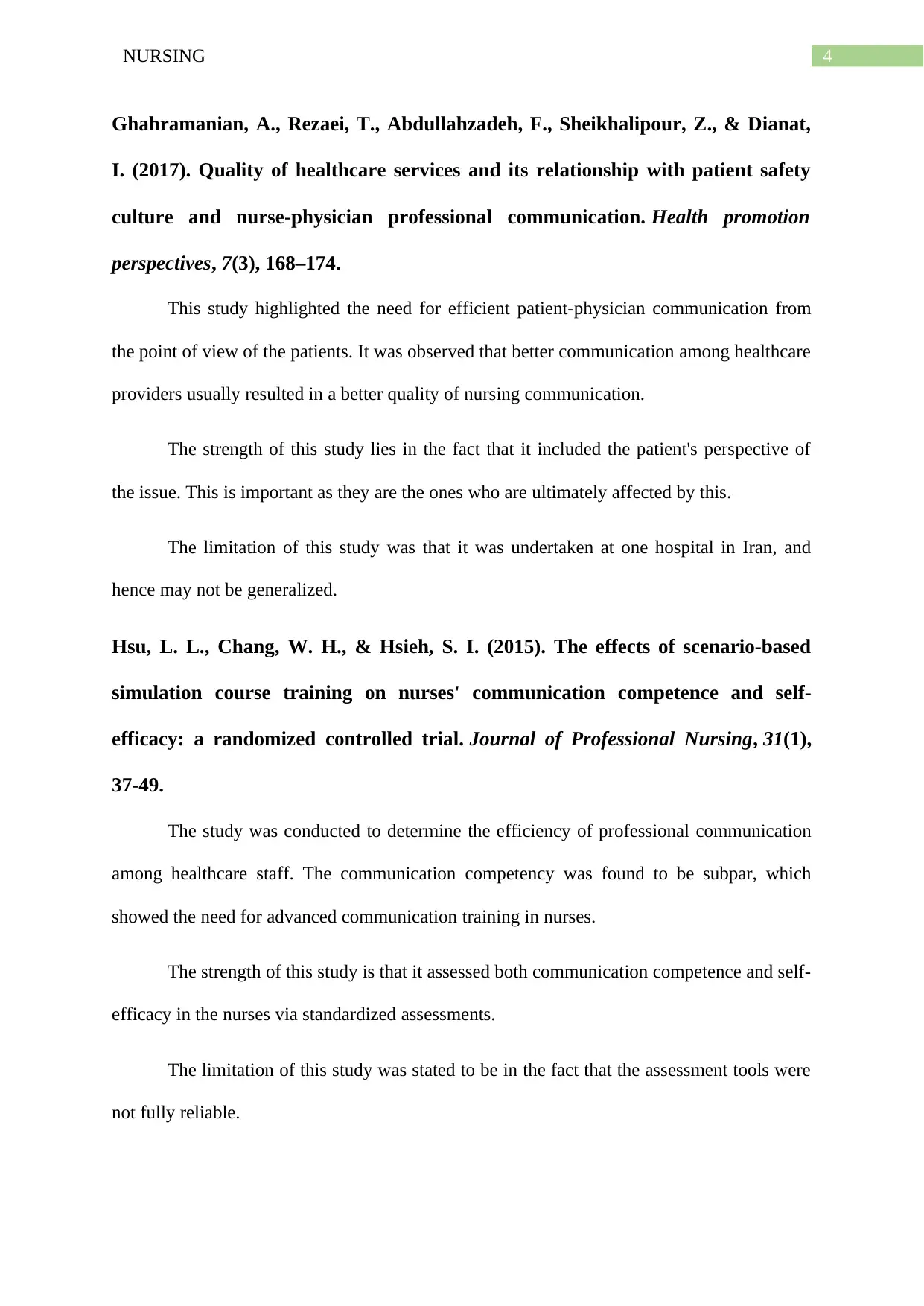
4NURSING
Ghahramanian, A., Rezaei, T., Abdullahzadeh, F., Sheikhalipour, Z., & Dianat,
I. (2017). Quality of healthcare services and its relationship with patient safety
culture and nurse-physician professional communication. Health promotion
perspectives, 7(3), 168–174.
This study highlighted the need for efficient patient-physician communication from
the point of view of the patients. It was observed that better communication among healthcare
providers usually resulted in a better quality of nursing communication.
The strength of this study lies in the fact that it included the patient's perspective of
the issue. This is important as they are the ones who are ultimately affected by this.
The limitation of this study was that it was undertaken at one hospital in Iran, and
hence may not be generalized.
Hsu, L. L., Chang, W. H., & Hsieh, S. I. (2015). The effects of scenario-based
simulation course training on nurses' communication competence and self-
efficacy: a randomized controlled trial. Journal of Professional Nursing, 31(1),
37-49.
The study was conducted to determine the efficiency of professional communication
among healthcare staff. The communication competency was found to be subpar, which
showed the need for advanced communication training in nurses.
The strength of this study is that it assessed both communication competence and self-
efficacy in the nurses via standardized assessments.
The limitation of this study was stated to be in the fact that the assessment tools were
not fully reliable.
Ghahramanian, A., Rezaei, T., Abdullahzadeh, F., Sheikhalipour, Z., & Dianat,
I. (2017). Quality of healthcare services and its relationship with patient safety
culture and nurse-physician professional communication. Health promotion
perspectives, 7(3), 168–174.
This study highlighted the need for efficient patient-physician communication from
the point of view of the patients. It was observed that better communication among healthcare
providers usually resulted in a better quality of nursing communication.
The strength of this study lies in the fact that it included the patient's perspective of
the issue. This is important as they are the ones who are ultimately affected by this.
The limitation of this study was that it was undertaken at one hospital in Iran, and
hence may not be generalized.
Hsu, L. L., Chang, W. H., & Hsieh, S. I. (2015). The effects of scenario-based
simulation course training on nurses' communication competence and self-
efficacy: a randomized controlled trial. Journal of Professional Nursing, 31(1),
37-49.
The study was conducted to determine the efficiency of professional communication
among healthcare staff. The communication competency was found to be subpar, which
showed the need for advanced communication training in nurses.
The strength of this study is that it assessed both communication competence and self-
efficacy in the nurses via standardized assessments.
The limitation of this study was stated to be in the fact that the assessment tools were
not fully reliable.
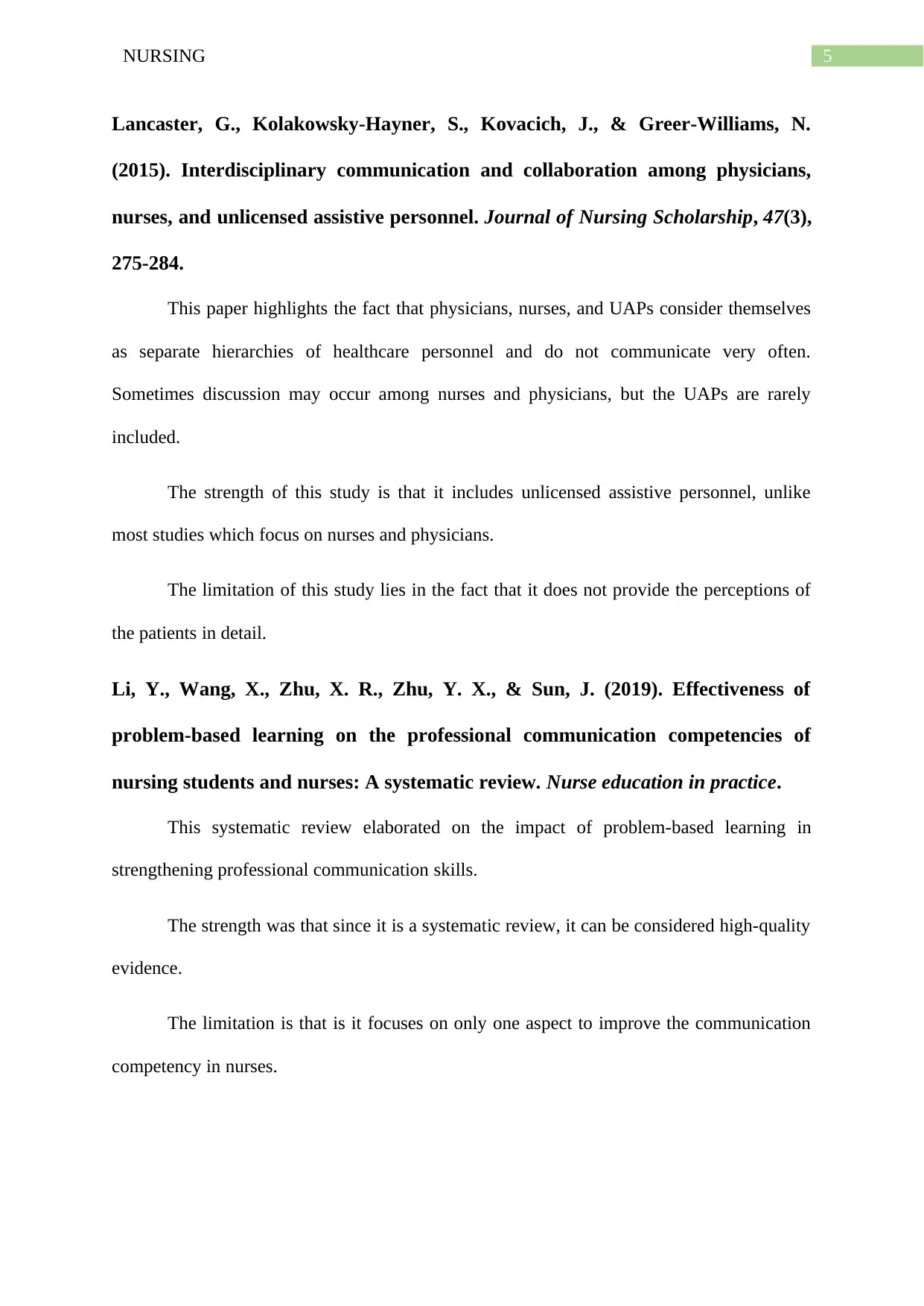
5NURSING
Lancaster, G., Kolakowsky‐Hayner, S., Kovacich, J., & Greer‐Williams, N.
(2015). Interdisciplinary communication and collaboration among physicians,
nurses, and unlicensed assistive personnel. Journal of Nursing Scholarship, 47(3),
275-284.
This paper highlights the fact that physicians, nurses, and UAPs consider themselves
as separate hierarchies of healthcare personnel and do not communicate very often.
Sometimes discussion may occur among nurses and physicians, but the UAPs are rarely
included.
The strength of this study is that it includes unlicensed assistive personnel, unlike
most studies which focus on nurses and physicians.
The limitation of this study lies in the fact that it does not provide the perceptions of
the patients in detail.
Li, Y., Wang, X., Zhu, X. R., Zhu, Y. X., & Sun, J. (2019). Effectiveness of
problem-based learning on the professional communication competencies of
nursing students and nurses: A systematic review. Nurse education in practice.
This systematic review elaborated on the impact of problem-based learning in
strengthening professional communication skills.
The strength was that since it is a systematic review, it can be considered high-quality
evidence.
The limitation is that is it focuses on only one aspect to improve the communication
competency in nurses.
Lancaster, G., Kolakowsky‐Hayner, S., Kovacich, J., & Greer‐Williams, N.
(2015). Interdisciplinary communication and collaboration among physicians,
nurses, and unlicensed assistive personnel. Journal of Nursing Scholarship, 47(3),
275-284.
This paper highlights the fact that physicians, nurses, and UAPs consider themselves
as separate hierarchies of healthcare personnel and do not communicate very often.
Sometimes discussion may occur among nurses and physicians, but the UAPs are rarely
included.
The strength of this study is that it includes unlicensed assistive personnel, unlike
most studies which focus on nurses and physicians.
The limitation of this study lies in the fact that it does not provide the perceptions of
the patients in detail.
Li, Y., Wang, X., Zhu, X. R., Zhu, Y. X., & Sun, J. (2019). Effectiveness of
problem-based learning on the professional communication competencies of
nursing students and nurses: A systematic review. Nurse education in practice.
This systematic review elaborated on the impact of problem-based learning in
strengthening professional communication skills.
The strength was that since it is a systematic review, it can be considered high-quality
evidence.
The limitation is that is it focuses on only one aspect to improve the communication
competency in nurses.
⊘ This is a preview!⊘
Do you want full access?
Subscribe today to unlock all pages.

Trusted by 1+ million students worldwide
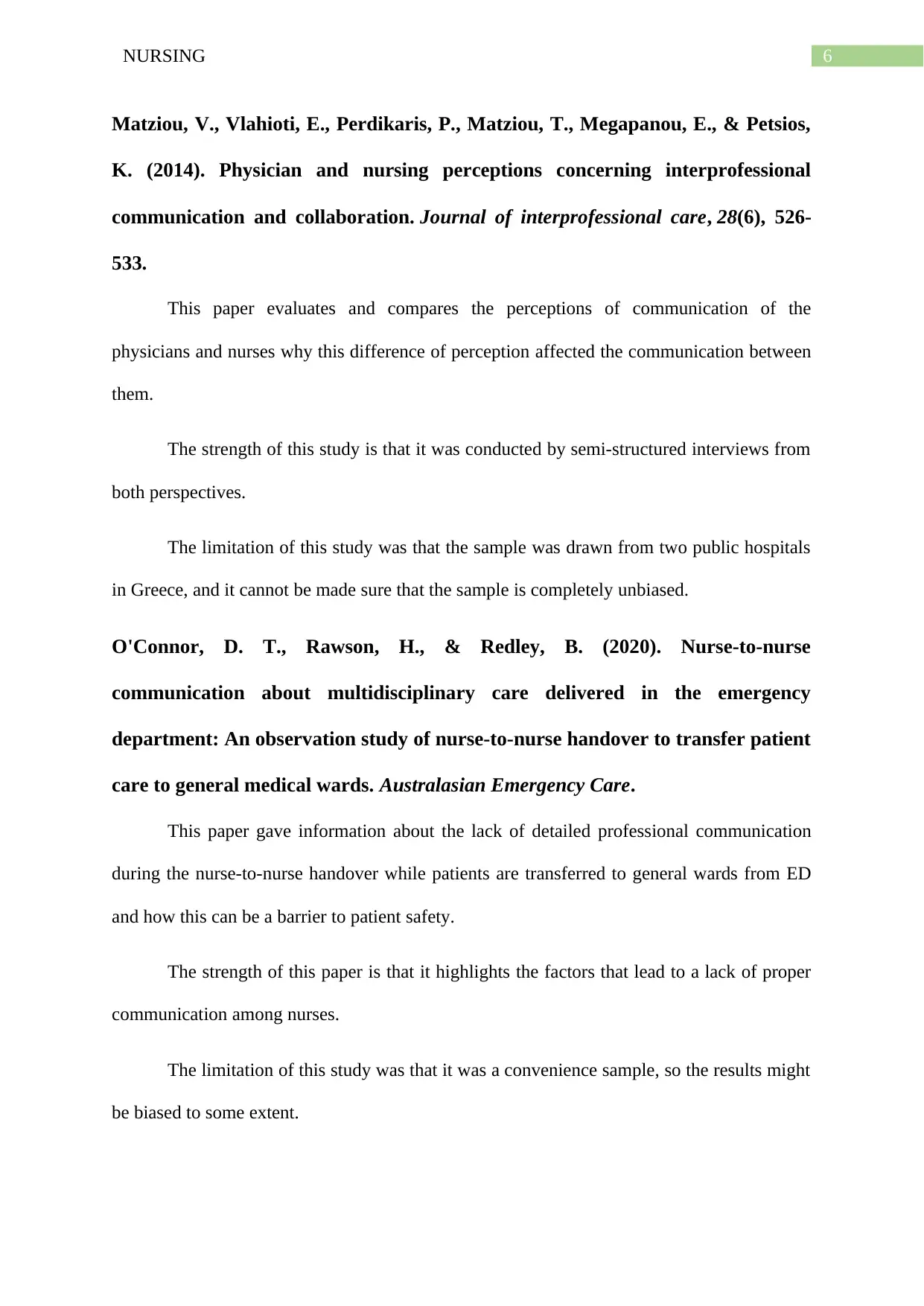
6NURSING
Matziou, V., Vlahioti, E., Perdikaris, P., Matziou, T., Megapanou, E., & Petsios,
K. (2014). Physician and nursing perceptions concerning interprofessional
communication and collaboration. Journal of interprofessional care, 28(6), 526-
533.
This paper evaluates and compares the perceptions of communication of the
physicians and nurses why this difference of perception affected the communication between
them.
The strength of this study is that it was conducted by semi-structured interviews from
both perspectives.
The limitation of this study was that the sample was drawn from two public hospitals
in Greece, and it cannot be made sure that the sample is completely unbiased.
O'Connor, D. T., Rawson, H., & Redley, B. (2020). Nurse-to-nurse
communication about multidisciplinary care delivered in the emergency
department: An observation study of nurse-to-nurse handover to transfer patient
care to general medical wards. Australasian Emergency Care.
This paper gave information about the lack of detailed professional communication
during the nurse-to-nurse handover while patients are transferred to general wards from ED
and how this can be a barrier to patient safety.
The strength of this paper is that it highlights the factors that lead to a lack of proper
communication among nurses.
The limitation of this study was that it was a convenience sample, so the results might
be biased to some extent.
Matziou, V., Vlahioti, E., Perdikaris, P., Matziou, T., Megapanou, E., & Petsios,
K. (2014). Physician and nursing perceptions concerning interprofessional
communication and collaboration. Journal of interprofessional care, 28(6), 526-
533.
This paper evaluates and compares the perceptions of communication of the
physicians and nurses why this difference of perception affected the communication between
them.
The strength of this study is that it was conducted by semi-structured interviews from
both perspectives.
The limitation of this study was that the sample was drawn from two public hospitals
in Greece, and it cannot be made sure that the sample is completely unbiased.
O'Connor, D. T., Rawson, H., & Redley, B. (2020). Nurse-to-nurse
communication about multidisciplinary care delivered in the emergency
department: An observation study of nurse-to-nurse handover to transfer patient
care to general medical wards. Australasian Emergency Care.
This paper gave information about the lack of detailed professional communication
during the nurse-to-nurse handover while patients are transferred to general wards from ED
and how this can be a barrier to patient safety.
The strength of this paper is that it highlights the factors that lead to a lack of proper
communication among nurses.
The limitation of this study was that it was a convenience sample, so the results might
be biased to some extent.
Paraphrase This Document
Need a fresh take? Get an instant paraphrase of this document with our AI Paraphraser
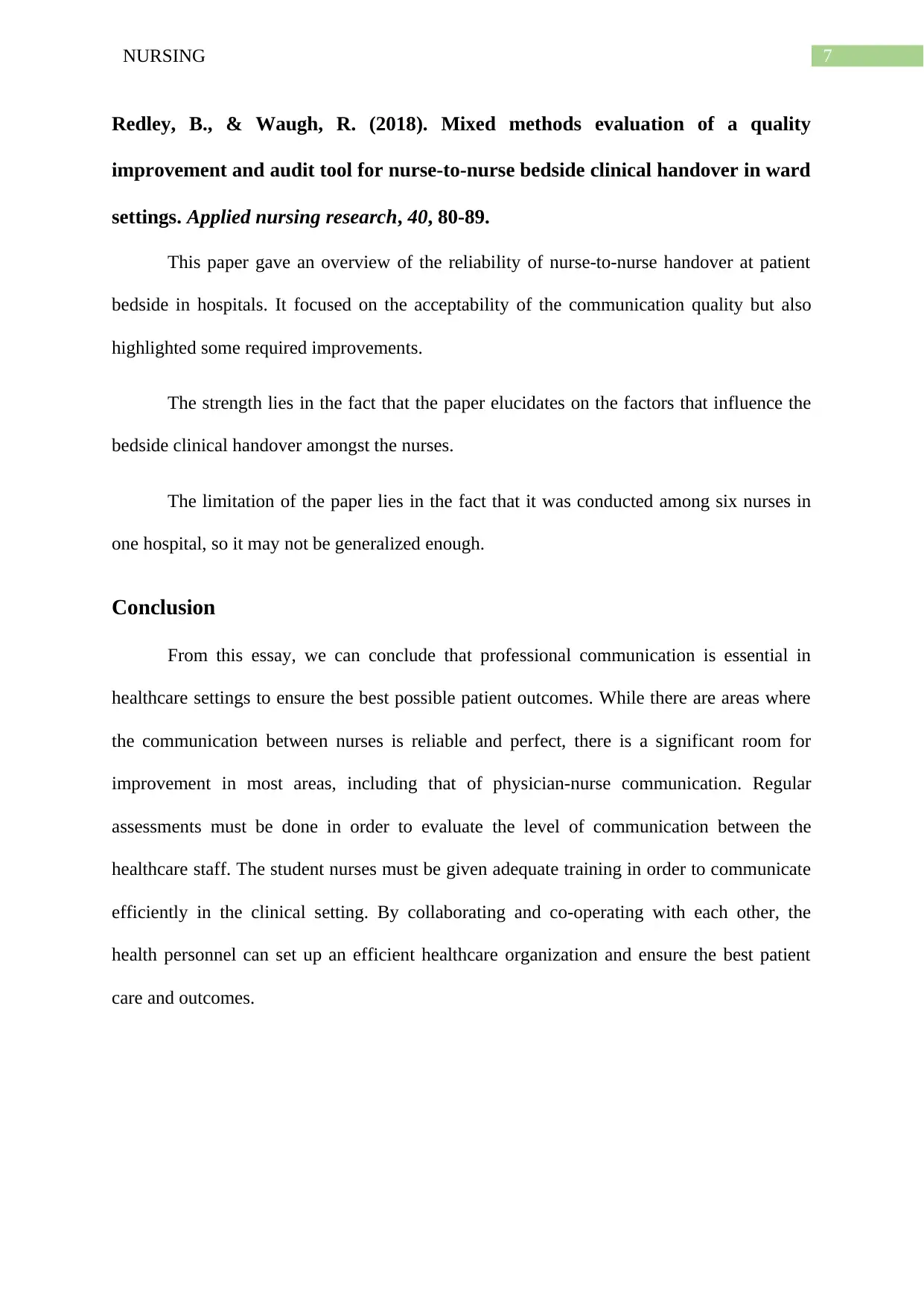
7NURSING
Redley, B., & Waugh, R. (2018). Mixed methods evaluation of a quality
improvement and audit tool for nurse-to-nurse bedside clinical handover in ward
settings. Applied nursing research, 40, 80-89.
This paper gave an overview of the reliability of nurse-to-nurse handover at patient
bedside in hospitals. It focused on the acceptability of the communication quality but also
highlighted some required improvements.
The strength lies in the fact that the paper elucidates on the factors that influence the
bedside clinical handover amongst the nurses.
The limitation of the paper lies in the fact that it was conducted among six nurses in
one hospital, so it may not be generalized enough.
Conclusion
From this essay, we can conclude that professional communication is essential in
healthcare settings to ensure the best possible patient outcomes. While there are areas where
the communication between nurses is reliable and perfect, there is a significant room for
improvement in most areas, including that of physician-nurse communication. Regular
assessments must be done in order to evaluate the level of communication between the
healthcare staff. The student nurses must be given adequate training in order to communicate
efficiently in the clinical setting. By collaborating and co-operating with each other, the
health personnel can set up an efficient healthcare organization and ensure the best patient
care and outcomes.
Redley, B., & Waugh, R. (2018). Mixed methods evaluation of a quality
improvement and audit tool for nurse-to-nurse bedside clinical handover in ward
settings. Applied nursing research, 40, 80-89.
This paper gave an overview of the reliability of nurse-to-nurse handover at patient
bedside in hospitals. It focused on the acceptability of the communication quality but also
highlighted some required improvements.
The strength lies in the fact that the paper elucidates on the factors that influence the
bedside clinical handover amongst the nurses.
The limitation of the paper lies in the fact that it was conducted among six nurses in
one hospital, so it may not be generalized enough.
Conclusion
From this essay, we can conclude that professional communication is essential in
healthcare settings to ensure the best possible patient outcomes. While there are areas where
the communication between nurses is reliable and perfect, there is a significant room for
improvement in most areas, including that of physician-nurse communication. Regular
assessments must be done in order to evaluate the level of communication between the
healthcare staff. The student nurses must be given adequate training in order to communicate
efficiently in the clinical setting. By collaborating and co-operating with each other, the
health personnel can set up an efficient healthcare organization and ensure the best patient
care and outcomes.
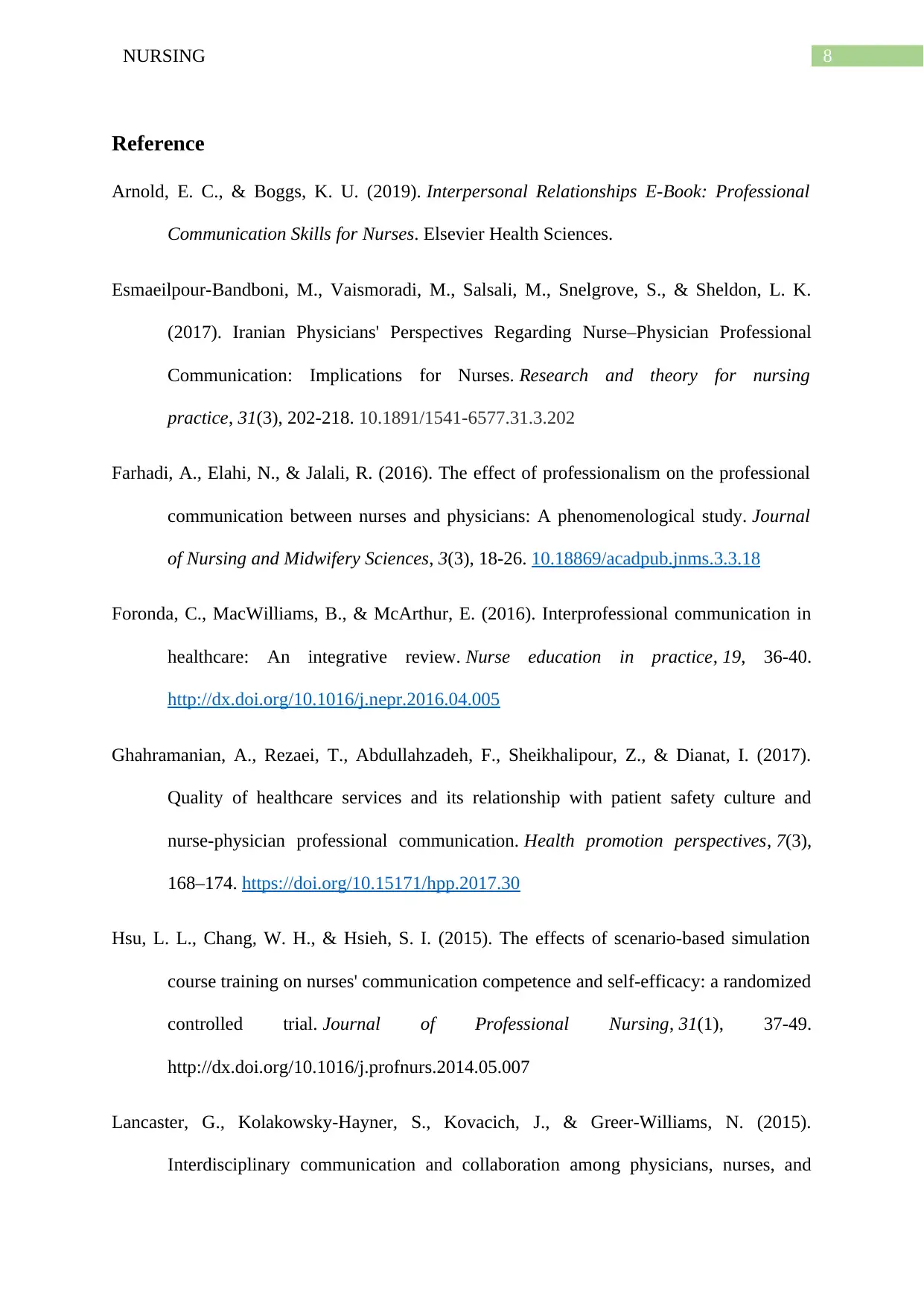
8NURSING
Reference
Arnold, E. C., & Boggs, K. U. (2019). Interpersonal Relationships E-Book: Professional
Communication Skills for Nurses. Elsevier Health Sciences.
Esmaeilpour-Bandboni, M., Vaismoradi, M., Salsali, M., Snelgrove, S., & Sheldon, L. K.
(2017). Iranian Physicians' Perspectives Regarding Nurse–Physician Professional
Communication: Implications for Nurses. Research and theory for nursing
practice, 31(3), 202-218. 10.1891/1541-6577.31.3.202
Farhadi, A., Elahi, N., & Jalali, R. (2016). The effect of professionalism on the professional
communication between nurses and physicians: A phenomenological study. Journal
of Nursing and Midwifery Sciences, 3(3), 18-26. 10.18869/acadpub.jnms.3.3.18
Foronda, C., MacWilliams, B., & McArthur, E. (2016). Interprofessional communication in
healthcare: An integrative review. Nurse education in practice, 19, 36-40.
http://dx.doi.org/10.1016/j.nepr.2016.04.005
Ghahramanian, A., Rezaei, T., Abdullahzadeh, F., Sheikhalipour, Z., & Dianat, I. (2017).
Quality of healthcare services and its relationship with patient safety culture and
nurse-physician professional communication. Health promotion perspectives, 7(3),
168–174. https://doi.org/10.15171/hpp.2017.30
Hsu, L. L., Chang, W. H., & Hsieh, S. I. (2015). The effects of scenario-based simulation
course training on nurses' communication competence and self-efficacy: a randomized
controlled trial. Journal of Professional Nursing, 31(1), 37-49.
http://dx.doi.org/10.1016/j.profnurs.2014.05.007
Lancaster, G., Kolakowsky‐Hayner, S., Kovacich, J., & Greer‐Williams, N. (2015).
Interdisciplinary communication and collaboration among physicians, nurses, and
Reference
Arnold, E. C., & Boggs, K. U. (2019). Interpersonal Relationships E-Book: Professional
Communication Skills for Nurses. Elsevier Health Sciences.
Esmaeilpour-Bandboni, M., Vaismoradi, M., Salsali, M., Snelgrove, S., & Sheldon, L. K.
(2017). Iranian Physicians' Perspectives Regarding Nurse–Physician Professional
Communication: Implications for Nurses. Research and theory for nursing
practice, 31(3), 202-218. 10.1891/1541-6577.31.3.202
Farhadi, A., Elahi, N., & Jalali, R. (2016). The effect of professionalism on the professional
communication between nurses and physicians: A phenomenological study. Journal
of Nursing and Midwifery Sciences, 3(3), 18-26. 10.18869/acadpub.jnms.3.3.18
Foronda, C., MacWilliams, B., & McArthur, E. (2016). Interprofessional communication in
healthcare: An integrative review. Nurse education in practice, 19, 36-40.
http://dx.doi.org/10.1016/j.nepr.2016.04.005
Ghahramanian, A., Rezaei, T., Abdullahzadeh, F., Sheikhalipour, Z., & Dianat, I. (2017).
Quality of healthcare services and its relationship with patient safety culture and
nurse-physician professional communication. Health promotion perspectives, 7(3),
168–174. https://doi.org/10.15171/hpp.2017.30
Hsu, L. L., Chang, W. H., & Hsieh, S. I. (2015). The effects of scenario-based simulation
course training on nurses' communication competence and self-efficacy: a randomized
controlled trial. Journal of Professional Nursing, 31(1), 37-49.
http://dx.doi.org/10.1016/j.profnurs.2014.05.007
Lancaster, G., Kolakowsky‐Hayner, S., Kovacich, J., & Greer‐Williams, N. (2015).
Interdisciplinary communication and collaboration among physicians, nurses, and
⊘ This is a preview!⊘
Do you want full access?
Subscribe today to unlock all pages.

Trusted by 1+ million students worldwide
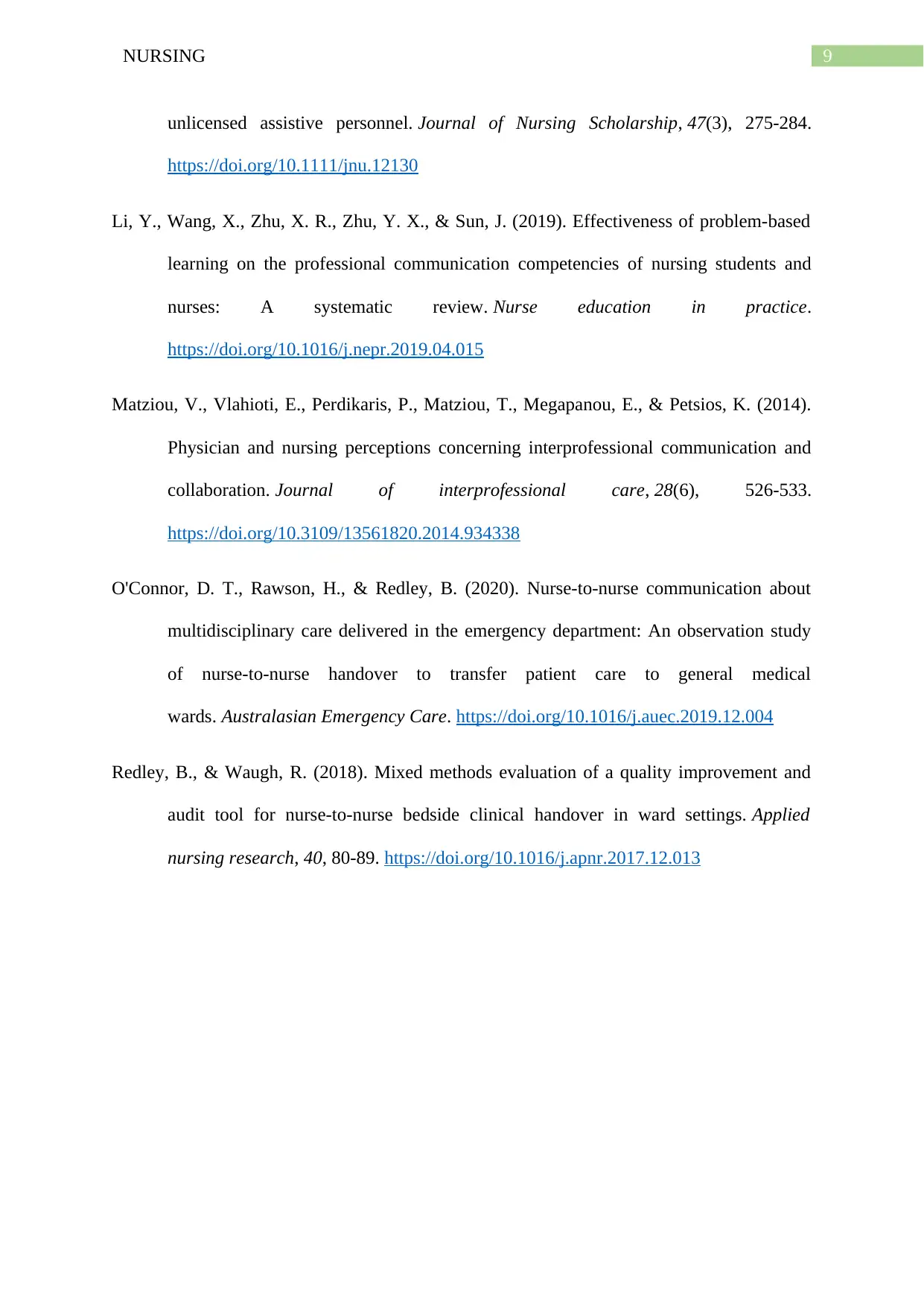
9NURSING
unlicensed assistive personnel. Journal of Nursing Scholarship, 47(3), 275-284.
https://doi.org/10.1111/jnu.12130
Li, Y., Wang, X., Zhu, X. R., Zhu, Y. X., & Sun, J. (2019). Effectiveness of problem-based
learning on the professional communication competencies of nursing students and
nurses: A systematic review. Nurse education in practice.
https://doi.org/10.1016/j.nepr.2019.04.015
Matziou, V., Vlahioti, E., Perdikaris, P., Matziou, T., Megapanou, E., & Petsios, K. (2014).
Physician and nursing perceptions concerning interprofessional communication and
collaboration. Journal of interprofessional care, 28(6), 526-533.
https://doi.org/10.3109/13561820.2014.934338
O'Connor, D. T., Rawson, H., & Redley, B. (2020). Nurse-to-nurse communication about
multidisciplinary care delivered in the emergency department: An observation study
of nurse-to-nurse handover to transfer patient care to general medical
wards. Australasian Emergency Care. https://doi.org/10.1016/j.auec.2019.12.004
Redley, B., & Waugh, R. (2018). Mixed methods evaluation of a quality improvement and
audit tool for nurse-to-nurse bedside clinical handover in ward settings. Applied
nursing research, 40, 80-89. https://doi.org/10.1016/j.apnr.2017.12.013
unlicensed assistive personnel. Journal of Nursing Scholarship, 47(3), 275-284.
https://doi.org/10.1111/jnu.12130
Li, Y., Wang, X., Zhu, X. R., Zhu, Y. X., & Sun, J. (2019). Effectiveness of problem-based
learning on the professional communication competencies of nursing students and
nurses: A systematic review. Nurse education in practice.
https://doi.org/10.1016/j.nepr.2019.04.015
Matziou, V., Vlahioti, E., Perdikaris, P., Matziou, T., Megapanou, E., & Petsios, K. (2014).
Physician and nursing perceptions concerning interprofessional communication and
collaboration. Journal of interprofessional care, 28(6), 526-533.
https://doi.org/10.3109/13561820.2014.934338
O'Connor, D. T., Rawson, H., & Redley, B. (2020). Nurse-to-nurse communication about
multidisciplinary care delivered in the emergency department: An observation study
of nurse-to-nurse handover to transfer patient care to general medical
wards. Australasian Emergency Care. https://doi.org/10.1016/j.auec.2019.12.004
Redley, B., & Waugh, R. (2018). Mixed methods evaluation of a quality improvement and
audit tool for nurse-to-nurse bedside clinical handover in ward settings. Applied
nursing research, 40, 80-89. https://doi.org/10.1016/j.apnr.2017.12.013
1 out of 10
Related Documents
Your All-in-One AI-Powered Toolkit for Academic Success.
+13062052269
info@desklib.com
Available 24*7 on WhatsApp / Email
![[object Object]](/_next/static/media/star-bottom.7253800d.svg)
Unlock your academic potential
Copyright © 2020–2025 A2Z Services. All Rights Reserved. Developed and managed by ZUCOL.





